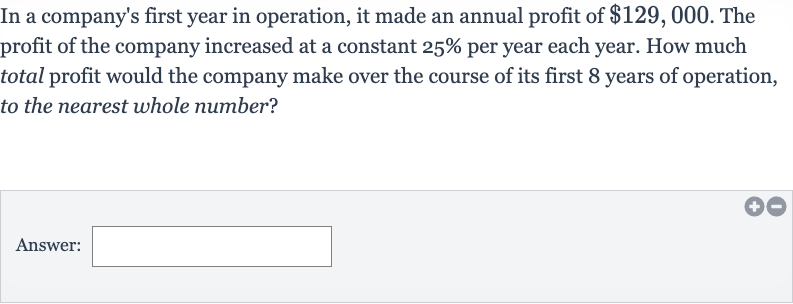AI tutor
Welcome to Bytelearn!
Let’s check out your problem:

In a company's first year in operation, it made an annual profit of . The profit of the company increased at a constant per year each year. How much total profit would the company make over the course of its first years of operation, to the nearest whole number?Answer:
Full solution
Q. In a company's first year in operation, it made an annual profit of . The profit of the company increased at a constant per year each year. How much total profit would the company make over the course of its first years of operation, to the nearest whole number?Answer:
- Determine initial profit and rate: Determine the initial profit and the annual increase rate.The initial profit is , and the profit increases by each year.
- Calculate profit for each year: Calculate the profit for each year using the formula for compound interest, which is , where is the initial amount, is the rate of increase, and is the number of years.For the first year, the profit is .
- Calculate profit for second year: Calculate the profit for the second year.The profit for the second year would be .
- Perform calculation for second year: Perform the calculation for the second year.
- Calculate profit for subsequent years: Continue this process to calculate the profit for each subsequent year up to the eighth year. We will use the formula for each year, incrementing by each time.
- Calculate total profit over years: Calculate the total profit over the years by adding the profit of each year.This requires calculating the profit for each year and then summing them up.
- Use loop or summation formula: Use a loop or a summation formula to calculate the total profit. Since this is a geometric series, we can use the formula for the sum of a geometric series, which is , where is the sum, is the initial amount, is the rate of increase, and is the number of terms.
- Substitute values into formula: Substitute the values into the formula to find the total profit. .
- Perform calculation: Perform the calculation..
- Calculate sum using calculator: Calculate the sum using a calculator or software to ensure accuracy..
- Calculate value of : Calculate the value of ..
- Substitute value into sum formula: Substitute this value into the sum formula..
- Calculate numerator of fraction: Calculate the numerator of the fraction. .
- Calculate total sum: Calculate the total sum..
- Perform final calculation: Perform the final calculation.
- Calculate total profit: Calculate the total profit to the nearest whole number..
More problems from Exponential growth and decay: word problems
QuestionGet tutor help
QuestionGet tutor help
QuestionGet tutor help
QuestionGet tutor help
QuestionGet tutor help
QuestionGet tutor help
QuestionGet tutor help
QuestionGet tutor help
QuestionGet tutor help
